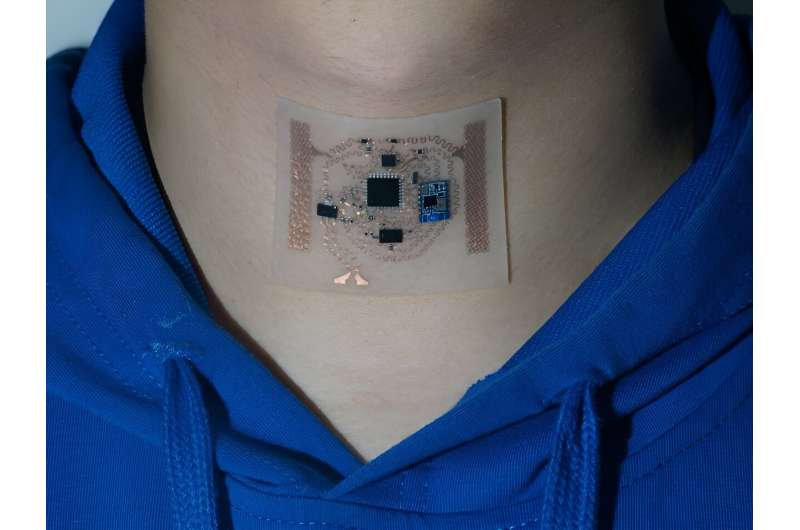This article has been reviewed according to Science X's editorial process and policies. Editors have highlighted the following attributes while ensuring the content's credibility:
fact-checked
peer-reviewed publication
trusted source
proofread
Health data, faster: Wearable stretchy sensor can process, predict health data

Wearable medical sensors have opened doors for remote health monitoring and treatment evaluation. But making diagnoses and treatment plans based on many datapoints—such as muscle movements, heart rate, breathing or speaking and swallowing—can be difficult for health care providers to do quickly.
Engineering researchers created a machine learning platform that can more efficiently analyze and predict data points collected by wearables, as reported in Nature Communications. They applied the platform to a new stretchy, wearable throat sensor that records vibrations and electrical muscle impulses from the neck area to monitor a user's speech and swallowing patterns.
"Soft, stretchy on-throat devices are needed in the health care market to continuously monitor the muscle and swallowing movements of patients with throat conditions to properly diagnose and treat them," said principal investigator Huanyu "Larry" Cheng, the James L. Henderson, Jr. Memorial Associate Professor of Engineering Science and Mechanics at Penn State. "Devices currently in use only provide limited information about the patient's health condition and are bulky and uncomfortable."
The wearable patch is composed of a composite hydrogel electrode interface, which was designed to withstand a user's movements on the skin surface while maintaining good signal quality, according to Cheng. The insoluble hydrogel material is flexible and easy to apply and remove.
"The hydrogel can directly interface with the skin and provides a conductive property for the sensors," Cheng said.
The hydrogel sensor collects vibrations and muscle movement data to feed a machine learning algorithm for analysis, according to co-principal investigator Libo Gao, associate professor in the Pen-Tung Sah Institute of Micro-Nano Science and Technology at Xiamen University, China. After collection and data analysis, the data is sent to a custom-built cloud interface, where health care providers can access it remotely.
"The patient data is collected by the patch at different frequencies, depending on the statistic type, such as swallowing, speaking or respiration," Gao said. "The algorithm groups the four frequencies into one streamlined output, which makes the data much more useful for health care providers to quickly look at and judge."
The algorithm has adaptive capabilities and memory functions, meaning after collecting the patient's throat movement data for one minute and training offline for three hours, it can predict patient data with over 90% accuracy, according to Gao.
Clinicians can use the predictive data to inform diagnoses earlier, as well as predict how treatments may work, Cheng said.
"Adaptive machine learning could also help account for the individual differences in data among a large population, so that researchers can make inferences on the health of a large population based on individual datasets," Cheng said.
More information: Hongcheng Xu et al, A fully integrated, standalone stretchable device platform with in-sensor adaptive machine learning for rehabilitation, Nature Communications (2023). DOI: 10.1038/s41467-023-43664-7



















